Chasing Comet 46p/Wirtanen
Comet 46p/Wirtanen is a short period comet with an orbital period of 5.4 years. This means that it returns to the vicinity of Earth about every 5 years, with some years approaching closer than others. This year it is coming partulary close, approaching to within 7.4 Million miles to the Earth. That’s close by astronomical scales. It is expected to have a brightness of Magnitude 3 or 4. When measuring magnitude the smaller the number the brighter the object. Under excellent conditions the unaided human eye can see objects down to magnitude 6, so it should be visible to the naked eye if they sky is clear and you get to somewhere very dark.
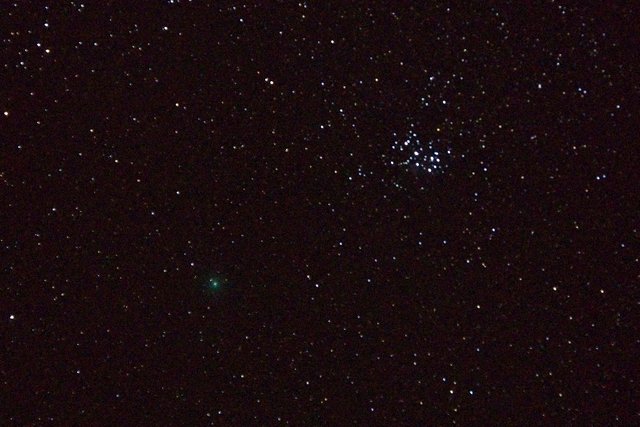
Comet 46p/Wirtanen and the Pleiades
I have been interested in astronomy for as long as I can remember, and this is not my first comet, however I have only been doing photography for a little over three years and this is the first comet I have had the chance to photograph. I thought I would write up a description of the processes involved in the way I do amateur astrophotography.
The first step in capturing an astronomical event, is you have to know that it is happening. You have to know when and where to look for it. I have a few places I check regularly to keep up with what is coming.
Photographer Alyn Wallace has an excellent channel on YouTube.
https://www.youtube.com/channel/UCKxQ3Dx6K95hpLpdJjTRIlg
Once a month he posts a video of events coming up in the next month, What's In The Night Sky or WITNS. This usually includes a challenge of some kind to photograph one of these events.
My other source for upcoming events is https://earthsky.org/ Not only will it keep you up to date on coming events, but will have detailed information on how to view it.
If you are going to do amateur astronomy then you are going to have to deal with the issue of Light Pollution. The sky is not perfectly clear. It contains dust and high clouds. If it is dark enough these may not be a problem, but when you add artificial light that is a different matter. The light reflects from the dust and clouds and makes the sky brighter. The brighter the sky the more it drowns out the dimmer objects. Due to light pollution some people can go years without ever seeing the Milky Way. Many people have never seen it, and have no idea of the true glory of the heavens. You can learn more about Light Pollution at: https://www.darksky.org/light-pollution/

Once I know what I want to see I have to decide how dark do I need it to be. Some things are brighter than others, and some can even be viewed from the middle of the city. In most cases though, I will need to get out of town. Sometimes way out of town. As a rule I always try for the darkest skies I can get to with the available time and budget. To find that I use: https://darksitefinder.com/ They have several useful tools but the one I use most is the light pollution map. This is a light pollution overlay over Google Maps. Just find the dark areas near where you are and zoom in to see what is there. If you live in Europe or the eastern half of the US, you may have to go quite a distance to find truly dark skies. Things are easier in the Western US, at least till you get to California. You can visit the website or there is an app called Dark Sky Map, which is pretty much the same site optimized for your phone.
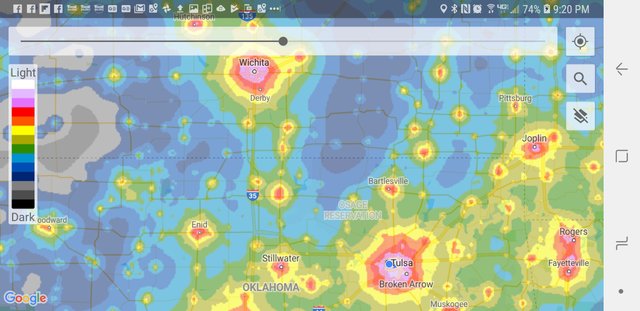
I live in Oklahoma, pretty much on the dividing line where the light pollution starts drop off a bit. I can get to reasonably dark skies in about two hours, very dark skies in three hours, and I am about seven and a half hours from some of the darkest skies in the US. To view the comet I was going to need reasonably dark skies. There are a handful of sites I use in this area and pretty much any of them would do. I didn’t want to take any vacation time, so I was looking to go out Friday or Saturday evening. The Comet would make its closest approach to Earth Sunday evening but a day or two to either side would be fine.
Once I knew when I wanted to go, there were two other considerations I had to take into account. The Moon, and the weather. It doesn’t help to drive for hours to get away from the light pollution if the Moon is up and putting out as much light as the cities, and none of it matters at all if it’s cloudy. The next thing was to check an app called Clear Outside. Essentially it is a weather app for astronomers. You can add and save your viewing locations, and it will tell you when the sun and moon rise and set, what percentage of cloud cover to expect hour to hour, and well as temperature, humidity, wind and wind chill.
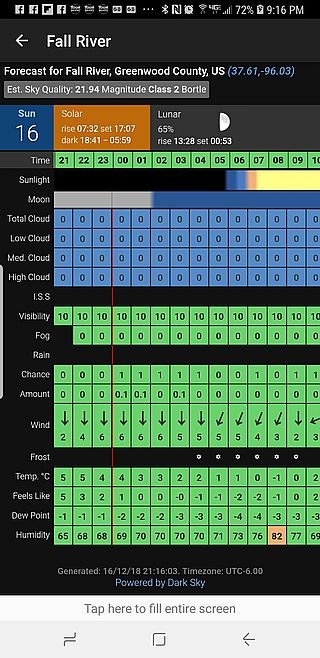
It rained here most of last week, and it was still raining Friday morning. Checking the Clear Outside app I saw that the rain was supposed to stop and the skies clear from Northwest to the Southeast. The Moon was just past first-quarter and headed toward full. It was going to set just about midnight. Looking at my sites to the south and east, it did not look like the clouds would clear much before morning. I didn’t really want to drive 8 hours to get to my far west Oklahoma site. That left North. There was another round of storms due in late Saturday, so it needed to be Friday. I had noted that there was fairly good viewing in South-Central Kansas extending down to just over the Oklahoma border, but hadn’t been there at night. The Oklahoma area was closer but it was the middle of nowhere, on back-country roads. There was a state park in Kansas that was further away but just off the highway so it was not much longer to drive, and I would have a place to camp and a bathroom. The skies were supposed to be clear well before the moon set. Kansas it was.
Ren and I got rid of our tent back when we had the RV, and never got around to replacing it. We have since decided that we prefer to camp in our hammocks. In fact we liked sleeping in our hammocks so much we got rid of our bed and sleep in the hammocks at home now. We had not yet tried out hammock camping in cold weather. We’ve studied it, and started to get our gear together, but haven’t actually done it yet. The low was predicted to be 29 F. I was prepared to give it a try, Ren was prepared to stay home and let me try it out first.
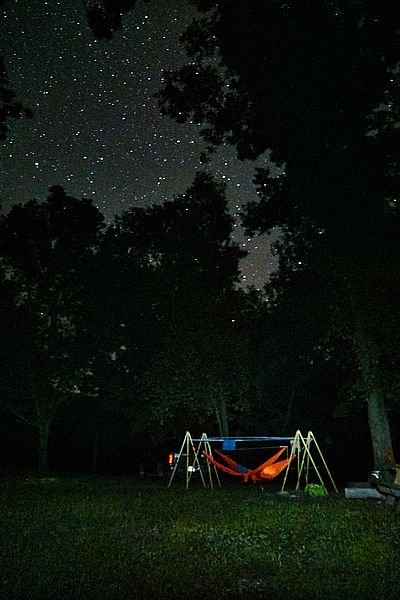
Hammock Camping in Missouri
I got everything together after work and hit the road about 6:00 I arrived at the Toronto Fall River State Park about 9:00 and encountered the problem that I had been expecting. State Parks like to talk about how dark it is, and promote stargazing in their parks, then light up the parks like Main Street. There were so many lights that it was not going to be suitable. I’ve run into this many times, so I was not surprised, just disappointed. I was going to have to locate a dark area somewhere around the lake, and then head back to camp when I was done. The map showed several promising areas, so I set out exploring the side roads looking for someplace dark, with a decent view of the sky. After a bit I found an small little park run by the Corps of Engineers. It was empty and had one yellow bulb outside the bathroom, and a few lights across the lake, but since the comet was directly overhead by then, a few distant lights on the horizon were not an issue.
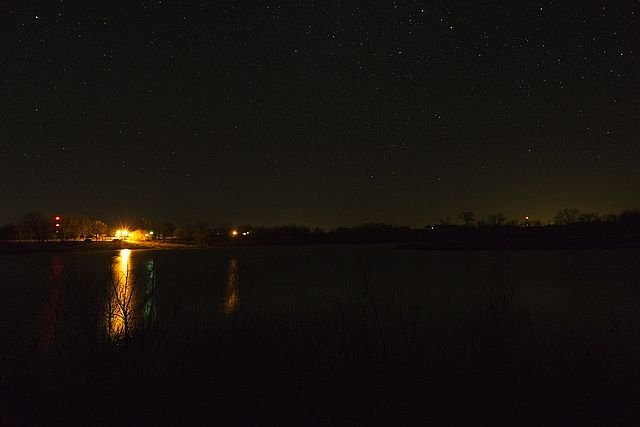
I had bundled up for the cold. The key is to wear several layers of clothes and put on or take off layers to adjust. You want to keep warm, but you do not want to sweat. Moisture will kill any insulation value. This worked well with one exception. My gloves were rather loose fitting, and I pretty much had to take them off to work the camera. In very short order my hands were freezing, and I hadn't brought anything with me to warm them up. I shot for about a hour before freezing hands made it no more fun, and I went to bed to warm up.
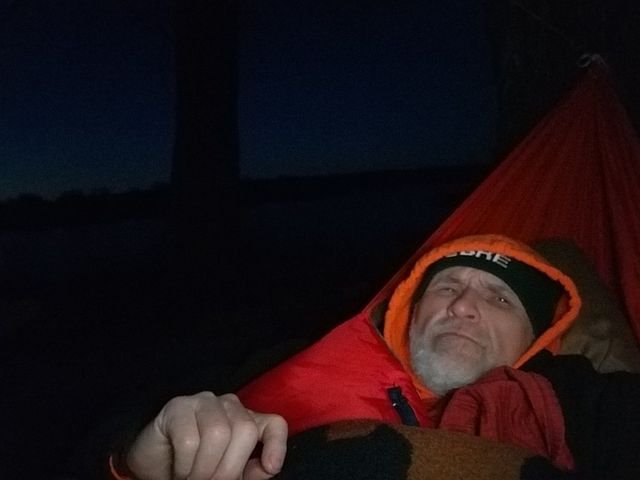
I do not have a telescope, or a Star-Tracker drive for my camera. I hope to have these at some point, but there are other things I want more, so it hasn’t been a priority. It is entirely possible to do astrophotography without either of these. The rotation of the Earth causes the stars to appear to move in the night sky. If you take a long exposure in order to collect more light, this will cause the stars to appear as lines in the photo rather than points, this is usually referred to as star trails. To compensate you can have a star-tracker drive that will move your camera to compensate for the movement of the stars. Without this you can still take star photos using the 500 rule. Take 500, divide by the focal length of your lens, and the resulting number is the longest exposure you can take without star trails. Using my 16 - 55 mm lens zoomed out to 16 mm I can take photos lasting up to 20 seconds with no problems. When I zoom in to 55 mm I need to reduce my exposure to about 10 seconds. With my Sony A6000 I can turn the ISO up high enough to get good photos with these settings, with acceptable noise levels. It is also possible to take multiple shorter exposures at higher ISO settings, and combine them in post production to reduce noise further.
Without a scope, or a tracking mount I was limited to wide exposures. I was never going to get an amazing close up picture of this rather small comet with this equipment. The greater the magnification I used the shorter the exposure I could do without star trails. This was never about trying to compete with the photos from the big telescopes. It’s about getting outside under the stars. It’s about learning to get the most out of the equipment I have, and trying new things. When I left the house I was not at all certain I was going to come back with a photo. Astrophotography is like that a lot of the time. So is landscape photography. You don’t know what you are going to end up with, if the weather or the light is going to break in your favor or shut you down. You just have to go out and shoot as often as you can and give yourself as many opportunities as possible to get lucky.
The winter camping worked worked out well. I was dressed in several layers of clothing, I had a sleeping bag, and under quilt, and two blankets. I was nice and warm despite a rather cutting wind. I never saw another person other than someone using the boat ramp as I was leaving.
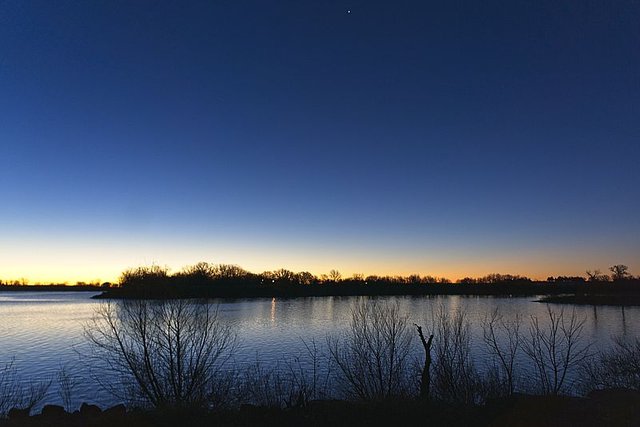
The View from my Hammock
It was a good trip.

Good job, Scott! Wish there was a way I could have helped you, I have a Meade 400mm refractor telescope, but no camera or phone mount for it; and I don't have a digital camera. All I have is a Minolta D11 35mm SLR and various lenses, but no way to connect it to the telescope. You still have a great shot though!
Thanks for the thought.
I do ok with what I have. I could have better gear if I chose to stay home and not spend my money on travel.
I choose to travel.
If you want to nbn take pictures through your telescope, you meet an adapter that fits in your eyepiece and attaches to your camera.
Scott
Posted using Partiko Android
Hiya, @itchyfeetdonica here. I just curated your post to our daily Travel Digest #395 and upvoted it through @steemitworldmap. If you enjoy what we do, consider supporting us by:
Vote for the Daily Traveldigest
Follow our curation trail
Delegate Steempower
The more support we get, the more we can give back! :)
This is an awesome write-up! I'm gonna check out some of these sites and try to see if I can't plan some camping / climbing trips to areas where there's some cool space stuff flyin' by!
Thanks.
Getting outside away from it all is always worthwhile.
Let me know nbn if you find something awesome.
Scott
Posted using Partiko Android
I had snapped a shot of it also. No masterpiece but here is a tight crop from a 10 stack of shots at 100mm. I really need a sky tracker !
Nice shot. I had intended to try at higher magnification, but it was too cold to mess with it. I was getting fumble fingered.
That is a nice shot!
Thank You
Posted using Partiko Android
Congratulations! Your high-quality travel content was selected by @travelfeed curator @guchtere and earned you a reward, in form of a 100% upvote and a resteem. Your work really stands out! Your article now has a chance to get featured under the appropriate daily topic on our TravelFeed blog.
Thank you for being part of the TravelFeed community!
Learn more about our travel project on Steemit by clicking on the banner above and join our community on Discord
Congratulations @scottf! You have completed the following achievement on the Steem blockchain and have been rewarded with new badge(s) :
Click here to view your Board of Honor
If you no longer want to receive notifications, reply to this comment with the word
STOP@bluefinstudios you would like this.
Congratulations, Your Post Has Been Added To The Steemit Worldmap!
Author link: http://steemitworldmap.com?author=scottf
Post link: http://steemitworldmap.com?post=chasing-46p-wirtanen
Want to have your post on the map too?
Congratulations @scottf! You have completed the following achievement on the Steem blockchain and have been rewarded with new badge(s) :
Click here to view your Board of Honor
If you no longer want to receive notifications, reply to this comment with the word
STOPCongratulations @scottf! You have completed the following achievement on the Steem blockchain and have been rewarded with new badge(s) :
Click here to view your Board of Honor
If you no longer want to receive notifications, reply to this comment with the word
STOP